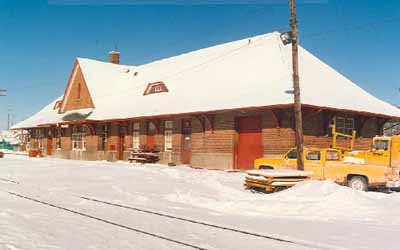Canadian Pacific Railway Station
Heritage Railway Station of Canada
Havelock, Ontario

General view of the place
(© Parks Canada Agency / Agence Parcs Canada, 1991.)
Address :
Ottawa Street (Hwy No. 7 at Orange St.), Havelock, Ontario
Recognition Statute:
Heritage Railway Stations Protection Act (R.S.C., 1985, c. 52 (4th Supp.))
Designation Date:
1991-06-10
Dates:
-
1914 to 1929
(Construction)
Event, Person, Organization:
-
Canadian Pacific Railway
(Organization)
Research Report Number:
RS-043
Description of Historic Place
The Canadian Pacific Railway (CPR) station at Havelock, Ontario is located on Ottawa St. which is also Highway 7. It is a picturesque single-storey brick building with a high pitched roof that was built 1914-1929. Today it remains the dominant landmark in a village that is still defined by the presence of railyards extending along the full southern edge of its east-west main corridor.
Heritage Value
The CPR station at Havelock has been designated a heritage railway station for its historical associations, its architectural character, and its importance within the community.
Havelock was established as an early divisional point for the Ontario and Quebec Railway, which served as the primary trunk line for the CPR in Ontario between 1884 and 1914. It was chosen for this role because it was located halfway between Toronto and Smiths Falls on available flat land near water sources. The town was surveyed from the site of its original 1883 station, which became the intersection between village life and railway activity. The economy of the community was largely dependent on Havelock ’s role as a railway divisional point. When the CPR built a new connection to Port McNicholl for wheat shipments in 1912, Havelock assumed a more important place in the company’s network. To reflect this change, the CPR undertook construction of a new station in 1914 near the site of its predecessor.
Architecturally, the building was to be an impressive example of the style the CPR had developed for divisional point stations, with their large hipped roofs, deep bracketed eaves, and horizontal layering in the walls. Unfortunately, World War I intervened before more than its foundation could be constructed, and the station was not completed until 1929. By that time, a new lakeshore route had diverted most of the Toronto traffic, and Havelock had begun a slow period of decline. The CPR freight depot closed in 1967, and passenger service to Havelock terminated in January 1990. Today the station remains the dominant landmark in a village that is still defined to great extent by the presence of the station and the railyards along the full southern extent of the main east-west corridor.
The heritage character of the Canadian Pacific Railway station at Havelock is defined by the full exterior of the building, those elements of the interior that reflect the original design and layout, and by its setting.
Source:
· Heritage Character Statement, Canadian Pacific Railway Station, Havelock, Ontario, August 1991. Heritage Assessment Report RSR-043,1991.
Character-Defining Elements
Character-defining elements of the Havelock Canadian Pacific Railway Station include:
the rectangular footprint, 1 storey massing, and high hipped bell-cast roof of the station cut by a prominent gable and dormers, its substantial proportions, the prominence of its roof definition from all four perspectives, the balance inherent in its vertical definition, the rhythmic placement of its apertures and brackets, the smooth aesthetic integration of special railway features such as a projecting telegrapher’s bay and broad eaves to provide passenger shelter, the picturesque inspiration of its details: its gable, its dormers, its prominent curved brackets, stone corbels, brick banding, multi-paned windows, wainscot line and broad eaves, the varying textures of its original materials: concrete lower walls, brick upper walls, stone and decorative tongue-and groove V-joint wood detailing, wooden doors and windows, the craftsmanship evident in its composition, all original fabric and finishes inside the station (on ceilings, floors, walls, doors, windows, partitions, and furnishings such as the metal screen and service counter of the ticket office), evidence of the hierarchy of materials and finishes originally distinguishing public, office and utility areas, surviving remnants of the early decor, in particular those that reflect the elegant tone of the public areas such as the terrazzo floor in the waiting room with its contrasting dark border, classically detailed baseboard, architrave moldings, high paneled wainscot, continuous wood picture rail and cove ceiling, continued legibility of the station’s original functional configuration and spatial volumes from both the interior and the exterior, continuity of its longstanding circulation patterns, the overall integrity of the building’s form, plan, material, and detail.